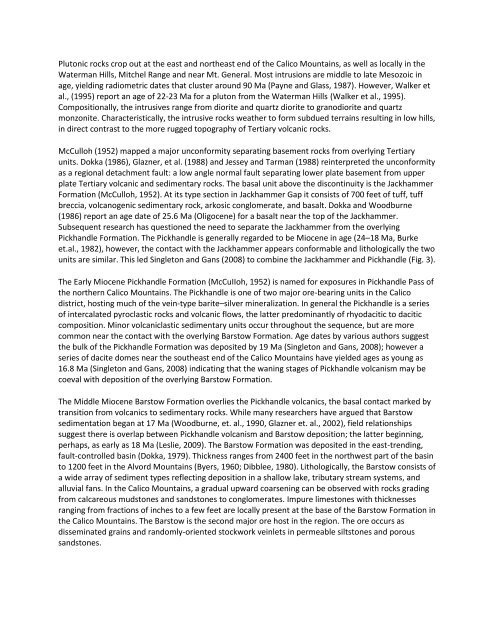Geology and Ore Genesis of Silver–Barite Mineralization in the ...
Geology and Ore Genesis of Silver–Barite Mineralization in the ...
Geology and Ore Genesis of Silver–Barite Mineralization in the ...
Create successful ePaper yourself
Turn your PDF publications into a flip-book with our unique Google optimized e-Paper software.
Plutonic rocks crop out at <strong>the</strong> east <strong>and</strong> nor<strong>the</strong>ast end <strong>of</strong> <strong>the</strong> Calico Mounta<strong>in</strong>s, as well as locally <strong>in</strong> <strong>the</strong><br />
Waterman Hills, Mitchel Range <strong>and</strong> near Mt. General. Most <strong>in</strong>trusions are middle to late Mesozoic <strong>in</strong><br />
age, yield<strong>in</strong>g radiometric dates that cluster around 90 Ma (Payne <strong>and</strong> Glass, 1987). However, Walker et<br />
al., (1995) report an age <strong>of</strong> 22-23 Ma for a pluton from <strong>the</strong> Waterman Hills (Walker et al., 1995).<br />
Compositionally, <strong>the</strong> <strong>in</strong>trusives range from diorite <strong>and</strong> quartz diorite to granodiorite <strong>and</strong> quartz<br />
monzonite. Characteristically, <strong>the</strong> <strong>in</strong>trusive rocks wea<strong>the</strong>r to form subdued terra<strong>in</strong>s result<strong>in</strong>g <strong>in</strong> low hills,<br />
<strong>in</strong> direct contrast to <strong>the</strong> more rugged topography <strong>of</strong> Tertiary volcanic rocks.<br />
McCulloh (1952) mapped a major unconformity separat<strong>in</strong>g basement rocks from overly<strong>in</strong>g Tertiary<br />
units. Dokka (1986), Glazner, et al. (1988) <strong>and</strong> Jessey <strong>and</strong> Tarman (1988) re<strong>in</strong>terpreted <strong>the</strong> unconformity<br />
as a regional detachment fault: a low angle normal fault separat<strong>in</strong>g lower plate basement from upper<br />
plate Tertiary volcanic <strong>and</strong> sedimentary rocks. The basal unit above <strong>the</strong> discont<strong>in</strong>uity is <strong>the</strong> Jackhammer<br />
Formation (McCulloh, 1952). At its type section <strong>in</strong> Jackhammer Gap it consists <strong>of</strong> 700 feet <strong>of</strong> tuff, tuff<br />
breccia, volcanogenic sedimentary rock, arkosic conglomerate, <strong>and</strong> basalt. Dokka <strong>and</strong> Woodburne<br />
(1986) report an age date <strong>of</strong> 25.6 Ma (Oligocene) for a basalt near <strong>the</strong> top <strong>of</strong> <strong>the</strong> Jackhammer.<br />
Subsequent research has questioned <strong>the</strong> need to separate <strong>the</strong> Jackhammer from <strong>the</strong> overly<strong>in</strong>g<br />
Pickh<strong>and</strong>le Formation. The Pickh<strong>and</strong>le is generally regarded to be Miocene <strong>in</strong> age (24–18 Ma, Burke<br />
et.al., 1982), however, <strong>the</strong> contact with <strong>the</strong> Jackhammer appears conformable <strong>and</strong> lithologically <strong>the</strong> two<br />
units are similar. This led S<strong>in</strong>gleton <strong>and</strong> Gans (2008) to comb<strong>in</strong>e <strong>the</strong> Jackhammer <strong>and</strong> Pickh<strong>and</strong>le (Fig. 3).<br />
The Early Miocene Pickh<strong>and</strong>le Formation (McCuIIoh, 1952) is named for exposures <strong>in</strong> Pickh<strong>and</strong>le Pass <strong>of</strong><br />
<strong>the</strong> nor<strong>the</strong>rn Calico Mounta<strong>in</strong>s. The Pickh<strong>and</strong>le is one <strong>of</strong> two major ore-bear<strong>in</strong>g units <strong>in</strong> <strong>the</strong> Calico<br />
district, host<strong>in</strong>g much <strong>of</strong> <strong>the</strong> ve<strong>in</strong>-type barite–silver m<strong>in</strong>eralization. In general <strong>the</strong> Pickh<strong>and</strong>le is a series<br />
<strong>of</strong> <strong>in</strong>tercalated pyroclastic rocks <strong>and</strong> volcanic flows, <strong>the</strong> latter predom<strong>in</strong>antly <strong>of</strong> rhyodacitic to dacitic<br />
composition. M<strong>in</strong>or volcaniclastic sedimentary units occur throughout <strong>the</strong> sequence, but are more<br />
common near <strong>the</strong> contact with <strong>the</strong> overly<strong>in</strong>g Barstow Formation. Age dates by various authors suggest<br />
<strong>the</strong> bulk <strong>of</strong> <strong>the</strong> Pickh<strong>and</strong>le Formation was deposited by 19 Ma (S<strong>in</strong>gleton <strong>and</strong> Gans, 2008); however a<br />
series <strong>of</strong> dacite domes near <strong>the</strong> sou<strong>the</strong>ast end <strong>of</strong> <strong>the</strong> Calico Mounta<strong>in</strong>s have yielded ages as young as<br />
16.8 Ma (S<strong>in</strong>gleton <strong>and</strong> Gans, 2008) <strong>in</strong>dicat<strong>in</strong>g that <strong>the</strong> wan<strong>in</strong>g stages <strong>of</strong> Pickh<strong>and</strong>le volcanism may be<br />
coeval with deposition <strong>of</strong> <strong>the</strong> overly<strong>in</strong>g Barstow Formation.<br />
The Middle Miocene Barstow Formation overlies <strong>the</strong> Pickh<strong>and</strong>le volcanics, <strong>the</strong> basal contact marked by<br />
transition from volcanics to sedimentary rocks. While many researchers have argued that Barstow<br />
sedimentation began at 17 Ma (Woodburne, et. al., 1990, Glazner et. al., 2002), field relationships<br />
suggest <strong>the</strong>re is overlap between Pickh<strong>and</strong>le volcanism <strong>and</strong> Barstow deposition; <strong>the</strong> latter beg<strong>in</strong>n<strong>in</strong>g,<br />
perhaps, as early as 18 Ma (Leslie, 2009). The Barstow Formation was deposited <strong>in</strong> <strong>the</strong> east-trend<strong>in</strong>g,<br />
fault-controlled bas<strong>in</strong> (Dokka, 1979). Thickness ranges from 2400 feet <strong>in</strong> <strong>the</strong> northwest part <strong>of</strong> <strong>the</strong> bas<strong>in</strong><br />
to 1200 feet <strong>in</strong> <strong>the</strong> Alvord Mounta<strong>in</strong>s (Byers, 1960; Dibblee, 1980). Lithologically, <strong>the</strong> Barstow consists <strong>of</strong><br />
a wide array <strong>of</strong> sediment types reflect<strong>in</strong>g deposition <strong>in</strong> a shallow lake, tributary stream systems, <strong>and</strong><br />
alluvial fans. In <strong>the</strong> Calico Mounta<strong>in</strong>s, a gradual upward coarsen<strong>in</strong>g can be observed with rocks grad<strong>in</strong>g<br />
from calcareous mudstones <strong>and</strong> s<strong>and</strong>stones to conglomerates. Impure limestones with thicknesses<br />
rang<strong>in</strong>g from fractions <strong>of</strong> <strong>in</strong>ches to a few feet are locally present at <strong>the</strong> base <strong>of</strong> <strong>the</strong> Barstow Formation <strong>in</strong><br />
<strong>the</strong> Calico Mounta<strong>in</strong>s. The Barstow is <strong>the</strong> second major ore host <strong>in</strong> <strong>the</strong> region. The ore occurs as<br />
dissem<strong>in</strong>ated gra<strong>in</strong>s <strong>and</strong> r<strong>and</strong>omly-oriented stockwork ve<strong>in</strong>lets <strong>in</strong> permeable siltstones <strong>and</strong> porous<br />
s<strong>and</strong>stones.

















